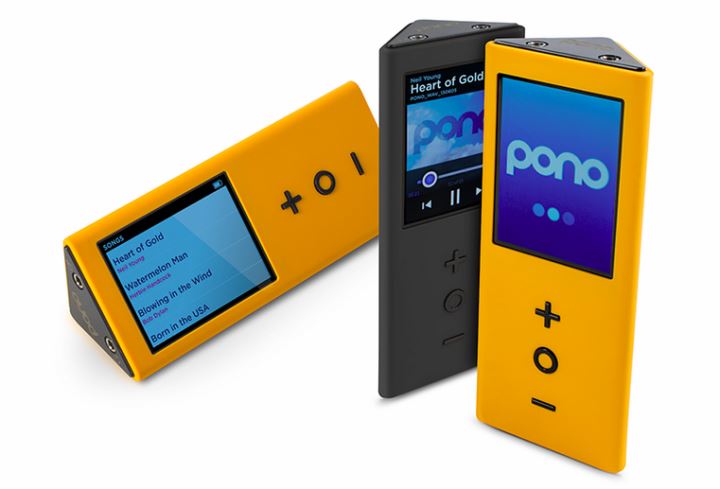
First, this is not about the Pono player. Aside from the size and limited storage, it is well spec’ed and well priced, and the involvement of Ayre is certainly reassuring. The size is what it is. Love it or leave it. I feel strongly that the internal memory should be at least 128GB and the SD card slot, which should be left empty, should be compatible with high capacity SDXC memory cards so the individual can choose what capacity he needs and is willing to pay for. If I were in the market for a stand-alone portable music player, it is an attractive alternative.
This is about the marketing message and the details of what will be offered in the PonoMusic store, including pricing, about which I am deeply troubled.
This from an interview of John Hamm, CEO of PonoMusic, by Spencer Holbert of The Absolute Sound:
“JH: All of the music on PonoMusic.com will be in FLAC, because FLAC is a universal audio codec that can be used by anyone. But users won’t even need to know that it’s FLAC, they will just download it and load it on their portable music device [presumably the Pono]. Resolutions will stay true to what the label recorded. Whether the label records in 44/16, 96/24, or 192/24, we will sell that file in its original form.
TAS: What are the price points for music sold on PonoMusic.com?
JH: Labels will set their own pricing. Most music will sell for $14.99–$24.99, depending on resolution and other factors.”
So it seems like “high resolution” doesn’t really mean high resolution; it simply means not lossy MP3s and ACCs. And it includes CD quality 44.1/16, exactly the resolution we have been offered since 1983, and about which Neil Young rails against in his many interviews as having killed the soul of the music. And have you looked at his “Underwater Listening” graphic? CD quality is 200 feet underwater represented by a scuba diver with air tanks on his back, presumably sucking for air. How can you, with any integrity, call CDs the death of sound quality, and then sell CD resolution downloads in your high resolution music store? For $14.99. But I am sure the labels will be delighted to sell CD equivalents to us all over again.
If Neil Young were serious about the high resolution mission he professes, he would offer at a reasonable price, i.e., significantly lower than the $17.99-$24.99 currently planned, only real high resolution music - music transferred from the original master analog tapes at at least 88.2/24 or originally recorded at at least 88.2/24, and not upsampled, downsampled or sidesampled during recording, mixing and mastering. And without the life squeezed out of it with excessive compression and limiting, about which Neil Young has said absolutely nothing. The problem is that there really isn’t very much music that meets those requirements to sell. They have to sell 44.1/16 if they want to offer any kind of catalog. So, 44.1/16 is now high resolution. Perfect sound forever. You can only shake your head and say at least it’s not an MP3. Maybe that could be Pono’s tagline: “Pono - at least it’s not MP3.™”
Moreover, if PonoMusic is going to sell CD quality files for back catalog albums for $14.99, why not just buy the CD used on Amazon or eBay for $1.00 and rip it to your computer instead. The target audience is tech savvy, right? And really, who is going to pay $14.99 for downloads of new releases at CD quality, quality which robs the music of its soul? Again, it’s cheaper to buy the CD on Amazon or, better yet, to download the album directly from the artist’s website. And it’s not much more trouble than downloading a file from PonoMusic. You are going to have to sync it to your Pono with a USB cable either way. For that matter, who is going to buy a whole album? Now uncompressed tracks at $0.99 each would be a different story. At least let us assemble our greatest hits uncompressed. If you are going to compete with Apple, and/or change the mindset of music consumers, you are going to have to offer better quality at the same or lower cost. Of course, with the labels in charge of pricing, there is no chance of that happening.
If I were a betting man, I would lay odds that the “masses” in this “revolution” are not going to pay $17.99 for 96/24 and $24.99 for 192/24 downloads for their $300 Pono player after the first half a dozen or so albums. They’ll quickly come to the realization that it is going to get really expensive really fast, and that will be the end of it. Query, did the masses rush out and replace all their VHS tapes and DVDs with Blu-rays when they got their HDTVs, or did they buy a few Blu-rays, acknowledge they looked awesome, and then unhesitatingly move on to lower quality streaming? I am sure Neil Young is sincere, but he is following the lead of the labels for the business model, which is the kiss of death.
I’m not trying to throw a wet blanket on the whole concept, but if you take Neil Young, his celebrity status, hyperbolic claims, vague and mystical sales pitch, stickers, t-shirts, signed posters, signature edition players, and ever expanding cross-country “exclusive” groupie dinners out of the equation, and examine the proposed model rationally from the point of view of the informed consumer, it throws a wet blanket on itself. Of course, the labels are all for it.
Yet many questions remain, and there is room for adjustments to the model before it launches six months (optimistically) from now. From my vantage point, the discussion has just begun. If not, then it’s all over but the shouting. Wait, the shouting started a week ago.
One question that has been answered, in response to a Billboard reporter’s question at the SXSW press conference, is that Neil Young and his fellow investors in PonoMusic will, like Apple, take a 30% cut of every download sold, regardless of sound quality. Now that’s putting the soul back in the music. Righteous!


